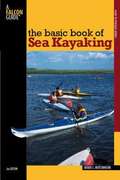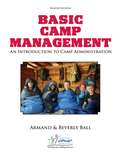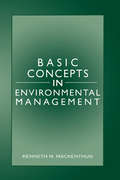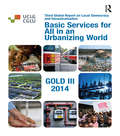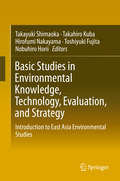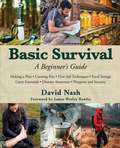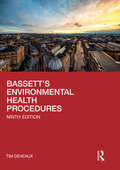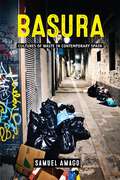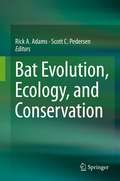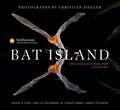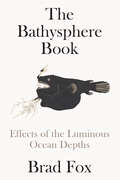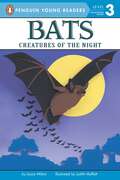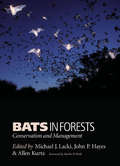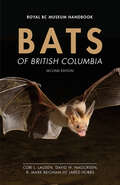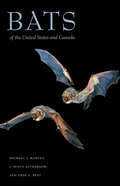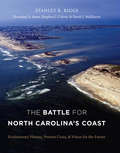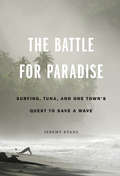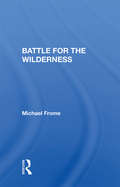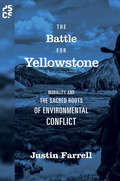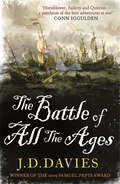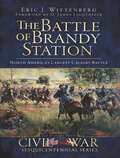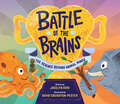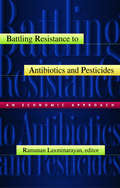- Table View
- List View
The Basic Book of Sea Kayaking (2nd edition)
by Derek C. HutchinsonA concise instruction book for beginners and a handy review guide for experienced paddlers, The Basic Book of Sea Kayaking is a must for anyone drawn to the sport of sea kayaking. Derek C. Hutchinson whittles his forty years of experience into five easy-to-understand chapters, covering the fundamentals of this exciting paddle sport. Whether kayaking for exercise, outdoor exploration, or pure fun, this book covers everything you need to know.
Basic Camp Management: An Introduction to Camp Administration
by Armand Ball Beverly BallManage your camp more effectively with the leading textbook for camp administration courses everywhere. The newly revised 8th edition of Basic Camp Management: An Introduction to Camp Administration provides overviews of 19 key areas that define successful camp operations, including the latest in outcomes and programming research, staff hiring and training, and business and technology, all of which are supported by nationally recognized standards from the American Camp Association.
Basic Concepts in Environmental Management
by Kenneth M. MackenthunEnvironmental professionals are (and will continue to be) under increased pressure to become more knowledgeable of environmental management issues.Basic Concepts in Environmental Management fulfills the long-standing need for fundamental knowledge-especially concerning government regulations on environmental and natural resource protection.As a leading environmental professional and consultant since the 1940s, Kenneth M. Mackenthun offers a unique perspective on the breadth, scope, and ever-constant change in environmental legislation at the federal, state, and local levels... and what those guidelines signify for industry and citizens alike.By maintaining an awareness of existing and forthcoming laws, environmentalists can substantially enhance their career potential-and be in a better position to protect the land, air, and sea. The starting point for that knowledge: Basic Concepts in Environmental Management.
Basic Services for All in an Urbanizing World
by UclgUCLG’s Third Global Report on Local Democracy and Decentralization (GOLD III) examines basic service provision and the current state-of-play of the local governance of basic services around the world. Basic Services for All in an Urbanizing World examines the enormous challenge of ensuring the universal provision of basic services in a world that is being shaped by rapid global urbanization, climate change, and economic, social and technological transformation. The world’s urban population is predicted to reach 5 billion people within the next 20-30 years. The report analyses the conditions necessary for local governments to provide these new urban residents with quality basic services. Water, sanitation, waste management, transport and energy are essential, not only for the preservation of human life and dignity, but also in driving economic growth and ensuring social equality. Each chapter examines a world region, drawing on existing research and consultation with local authorities on the ground. The chapters review access levels, legal and institutional frameworks, and the different ways in which basic services are managed and financed, as well as showcasing diverse examples of innovation in the local and multi-level governance of services. It concludes with a set of recommendations for all stakeholders with a view to making the goal of basic services for all a reality. This report contributes to discussions on the Millennium Development Goals and the UN Post-2015 Development Agenda. The findings of GOLD III will also be essential to promoting the vision of local governments at the 2016 UN Conference on Human Settlements (Habitat III).
Basic Studies in Environmental Knowledge, Technology, Evaluation, and Strategy: Introduction to East Asia Environmental Studies
by Takayuki Shimaoka Takahiro Kuba Hirofumi Nakayama Toshiyuki Fujita Nobuhiro HoriiThis book covers diverse environmental issues such as climate change; biodiversity preservation; prevention of air, water, and soil pollution; and resource recycling. Readers can acquire these four practical interdisciplinary abilities: 1. knowledge; 2. technology; 3. evaluation; and 4. strategy in the diverse issues related to the environment. These abilities are fundamental to identifying the core essence of economic and ecological interdependence, to look at and analyze problems from an overarching perspective, and to consider countermeasures to be taken. Each chapter of this book corresponds to a lecture in the East Asia Environmental Strategist Training Program at Kyushu University and is excellent reading as a sourcebook.
Basic Survival: A Beginner's Guide
by James Wesley Rawles David NashMany people are beginning to become concerned by increasing natural disasters, global conflict, and political unrest and the smart ones want to do something about it. Unfortunately, increased awareness about disaster preparedness has caused an information overload. It is easy to become overwhelmed by the sheer amount of information available. Basic Survival helps readers dig out from under the avalanche of preparedness information. It dispels myths, introduces concepts, and teaches the basics of how to start preparing for disaster. Author David Nash, a lifelong prepper and the author of 52 Prepper Projects and The Prepper’s Guide to Foraging outlines an all-hazards approach to disaster management similar to the ones used by the military and federal and state governments. Nash has over ten years of experience in government emergency management as a planner, a first responder, and as an emergency operations center manager. Basic Survival is a great resource that presents a strong foundation for being prepared when an emergency hits.
Bassett's Environmental Health Procedures
by W.H. Bassett Tim DeveauxEnvironmental health law is a wide-ranging, detailed and complex body of law within the UK. Bassett’s Environmental Health Procedures is an established and essential reference source which provides an accessible entry into enforcement and administrative procedures for environmental health. The main legal procedures used in the environmental health field are presented as flow charts supported by explanatory text. This ninth edition refines the structure introduced in the eighth edition, with each chapter addressing a single topic. It has introduced the titles of the corresponding legislation in Scotland and Northern Ireland where there is such legislation. The book has been updated throughout to reflect new practices, legislation and statutory guidance. Specifically, the ninth edition contains new content on Antisocial Behaviour and significant updates to sections on: Enforcement and Administration Environmental Protection Food Safety Housing and Public Health Environmental Health Officers/Practitioners and students will find this book invaluable. It will also be an essential reference for all those whose responsibilities demand they keep abreast of current environmental health practices.
Basura: Cultures of Waste in Contemporary Spain (Under the Sign of Nature)
by Samuel AmagoWhat makes trash trash? How do we decide what to throw away? Driven by these questions and others, Samuel Amago takes us through the streets and alleys of Spain, sorting through recycling bins, libraries, social media, bookstores, and message boards in search of things that have been forgotten, jettisoned, forsaken. Ranging in topic from the transformation of urban space during the transition to democracy to a twenty-first-century sanitation strike that paralyzed Madrid for weeks, from the films of Pedro Almodóvar to graphic novels about Spain’s housing crisis, Basura presents an alternative story of contemporary Spanish culture through the lens of wasted things.Not merely an environmental problem, the proliferation of trash is an indicator of the social, political, and economic processes that undergird late, neoliberal capitalism. In chapters on cinema, photography, archaeology, drawing, comics, literature, ecology, and urban design, Amago places waste objects into dialogue with the cultural practices and structures of power that have produced them. Drawing from archaeological, ecocritical, and new materialist approaches, Amago argues that discards possess agency and generate an array of effects. Just as trash never fully disappears but returns to haunt its creators, so history never vanishes despite being buried or ignored by official narratives. Basura considers the efforts of artists, writers, and designers for whom waste is a means to withstand cultural erasure.
Bat Evolution, Ecology, and Conservation
by Rick A. Adams Scott C. PedersenRecent advances in the study of bats have changed the way we understand this illusive group of mammals. This volume consist of 25 chapters and 57 authors from around the globe all writing on the most recent finding on the evolution, ecology and conservation of bats. The chapters in this book are not intended to be exhaustive literature reviews, but instead extended manuscripts that bring new and fresh perspectives. Many chapters consist of previously unpublished data and are repetitive of new insights and understanding in bat evolution, ecology and conservation. All chapters were peer-reviewed and revised by the authors. Many of the chapters are multi-authored to provide comprehensive and authoritative coverage of the topics.
Bat Island: A Rare Journey into the Hidden World of Tropical Bats
by Dr. Rachel A. Page Dr. Dina K. Dechmann Dr. M. Teague O'Mara Dr. Marco Tschapka The Smithsonian Tropical Research InstituteFeaturing incredible photography and insight from an international team with long-term ties to the Smithsonian Tropical Research Institute, Bat Island spotlights the unique beauty and environmental importance of the seventy-six species of bats on Panama&’s Barro Colorado Island.For decades, scientists at the Smithsonian Tropical Research Institute have studied the remarkable biodiversity of bats on Barro Colorado Island in Panama, where an astonishing seventy-six species coexist. Now, for the first time, Smithsonian scientists&’ expertise pairs with the stunning photography of National Geographic contributor Christian Ziegler for a captivating visual journey into the fascinating world of these elusive night creatures. Bats are unique among mammals: they have acquired true flight, provide essential ecosystem services, and represent the ecologically most diverse group of mammals worldwide. Synthesizing decades-worth of intensive study, Drs. Rachel Page, Dina Dechmann, Teague O&’Mara, and Marco Tschapka provide authoritative insight alongside 150 photographs that showcase bats&’ extraordinary environmental adaptations and rich natural history. OVER 150 STUNNING PHOTOGRAPHS: National Geographic photographer and contributor Christian Ziegler has captured over a decade&’s worth of images of the myriad of bat species living on Barro Colorado Island that capture these elusive animals in a variety of settings, from night shots of flight through the tropical rainforest to closeups of their remarkable wings and feeding patterns. WRITTEN BY SMITHSONIAN SCIENTISTS: All chapters of Bat Island are written by scientists long affiliated with the Smithsonian Tropical Research Institute, one of the world&’s leading tropical research organizations that spans a century. Topics include bats&’ diverse sensory abilities, foraging strategies, roosting ecologies, and social systems. DECADES OF CUTTING-EDGE RESEARCH: Bat Island, published in partnership with the Smithsonian, presents fascinating insights from scientists working at the Smithsonian Tropical Research Institute, which boasts decades of study of the hyperdiverse bat population on Barro Colorado Island in addition to the most comprehensive and long-term datasets on tropical bats. CALL FOR CONSERVATION: Drs. Page, Dechmann, O&’Mara, and Tschapka highlight how bats are threatened by habit fragmentation and land degradation, and communicate the initiatives needed to ensure the survival of these animals, which are critical to maintaining healthy, balanced ecosystems. RARE BEAUTY: Award-winning photojournalist Christian Ziegler&’s photography illuminates the unique beauty and allure of bats and the tropical rainforest in Panama.
The Bathysphere Book: Effects of the Luminous Ocean Depths
by Brad Fox"Hypnotic . . . Beautifully written and beautifully made." —W. M. Akers, The New York Times Book Review"Mesmerizing . . . Original and often profound, [The Bathysphere Book] is a moving testament to the wonders of exploration."—Publishers Weekly, Starred Review "Imbued with the adventurous spirit of science and exploration . . . [The Bathysphere Book is] an enchanting cabinet of curiosities." —Kirkus Reviews A wide ranging, philosophical, and sensual account of early deep sea exploration and its afterlives, The Bathysphere Book begins with the first ever voyage to the deep ocean in 1930 and expands to explore the adventures and entanglements of its all-too-human participants at a time when the world still felt entirely new.In the summer of 1930, aboard a ship floating near the Atlantic island of Nonsuch, marine biologist Gloria Hollister sat on a crate, writing furiously in a notebook with a telephone receiver pressed to her ear. The phone line was attached to a steel cable that plunged 3,000 feet into the sea. There, suspended by the cable, dangled a four-and-a-half-foot steel ball called the bathysphere. Crumpled inside, gazing through three-inch quartz windows at the undersea world, was Hollister&’s colleague William Beebe. He called up to her, describing previously unseen creatures, explosions of bioluminescence, and strange effects of light and color.From this momentous first encounter with the unknown depths, The Bathysphere Book widens its scope to explore a transforming and deeply paradoxical America, as the first great skyscrapers rose above New York City and the Great Plains baked to dust. In prose that is magical, atmospheric, and entirely engrossing, Brad Fox dramatizes new visions of our planetary home, delighting in tales of the colorful characters who surrounded, supported, and participated in the dives—from groundbreaking scientists and gallivanting adventurers to eugenicist billionaires.The Bathysphere Book is a hypnotic assemblage of brief chapters along with over fifty full-color images, records from the original bathysphere logbooks, and the moving story of surreptitious romance between Beebe and Hollister that anchors their exploration. Brad Fox blurs the line between poetry and research, unearthing and rendering a visionary meeting with the unknown.
Bats: Creatures Of The Night (Penguin Young Readers, Level 3)
by Joyce MiltonDid you know that bats are not blind? That the smallest bat is the size of a bee? That bats won't really fly into your hair? Kids will learn all this and more in this exciting book about one of nature's most misunderstood creatures.
Bats in Forests: Conservation and Management
by Michael J. LackiAlthough bats are often thought of as cave dwellers, many species depend on forests for all or part of the year. Of the 45 species of bats in North America, more than half depend on forests, using the bark of trees, tree cavities, or canopy foliage as roosting sites. Over the past two decades it has become increasingly clear that bat conservation and management are strongly linked to the health of forests within their range. Initially driven by concern for endangered species—the Indiana bat, for example—forest ecologists, timber managers, government agencies, and conservation organizations have been altering management plans and silvicultural practices to better accommodate bat species. Bats in Forests presents the work of a variety of experts who address many aspects of the ecology and conservation of bats. The chapter authors describe bat behavior, including the selection of roosts, foraging patterns, and seasonal migration as they relate to forests. They also discuss forest management and its influence on bat habitat. Both public lands and privately owned forests are considered, as well as techniques for monitoring bat populations and activity.The important role bats play in the ecology of forests—from control of insects to nutrient recycling—is revealed by a number of authors. Bat ecologists, bat conservationists, forest ecologists, and forest managers will find in this book an indispensable synthesis of the topics that concern them.
Bats! (Know It All)
by Roger GenerazzoA simple children's book about different kinds of bats, their habits, and other interesting facts.
Bats of British Columbia (Royal BC Museum Handbook)
by Cori Lausen David Nagorsen Mark Brigham Jared HobbsA full-colour, fully updated field guide to identifying British Columbia's bats, with new material on acoustic identification.Bats live on every continent except Antarctica and in virtually every type of habitat, from desert to forest. With more than 1,400 species worldwide, bats fill important ecological roles around the globe by controlling insect populations, pollinating plants, dispersing seeds and even providing humans with medicines--the saliva of the famous vampire bat can be used to treat strokes! Yet despite their importance to the planet's ecosystems, there remains more misinformation than fact and more fear than respect for these diminutive guardians of the night. Since 1993, when the first edition of Bats of British Columbia was published, an explosion in field studies of the province's bat fauna has produced a wealth of new knowledge, applying modern tools such as genetic techniques and acoustic bat detectors. This fully updated second edition includes new colour photographs throughout, with new material on acoustic identification. With in-depth information on biology, conservation, ecology and identification of the 18 bat species found in the province, the new Bats of British Columbia will help create an appreciation of this fascinating group of mammals.
Bats of the United States and Canada
by Michael J. Harvey J. Scott Altenbach Troy L. BestHonorable Mention, Popular Science, 2012 PROSE Awards, Professional and Scholarly Publishing Division of the Association of American PublishersThe only mammals capable of true flight, bats are among the world’s most fascinating creatures. This accessible guide to the forty-seven species of bats found in the United States and Canada captures and explains the amazing diversity of these marvels of evolution.A wide variety of bat species live in the United States and Canada, ranging from the California leaf-nosed bat to the Florida bonneted bat, from the eastern small-footed bat to the northern long-eared bat. The authors provide an overview of bat classification, biology, feeding behavior, habitats, migration, and reproduction. They discuss the ever-increasing danger bats face from destruction of habitat, wind turbines, chemical toxicants, and devastating diseases like white-nose syndrome, which is killing millions of cave bats in North America. Illustrated species accounts include range maps and useful identification tips. Written by three of the world’s leading bat experts and featuring J. Scott Altenbach's stunning photographs, this fact-filled and easy-to-use book is the most comprehensive and up-to-date account of bats in the U.S. and Canada.
The Battle for North Carolina's Coast: Evolutionary History, Present Crisis, and Vision for the Future
by Stanley R. RiggsThe North Carolina barrier islands, a 325-mile-long string of narrow sand islands that forms the coast of North Carolina, are one of the most beloved areas to live and visit in the United States. However, extensive barrier island segments and their associated wetlands are in jeopardy. In The Battle for North Carolina's Coast, four experts on coastal dynamics examine issues that threaten this state treasure. According to the authors, the North Carolina barrier islands are not permanent. Rather, they are highly mobile piles of sand that are impacted by sea-level rise and major storms and hurricanes. Our present development and management policies for these changing islands are in direct conflict with their natural dynamics. Revealing the urgency of the environmental and economic problems facing coastal North Carolina, this essential book offers a hopeful vision for the coast's future if we are willing to adapt to the barriers' ongoing and natural processes. This will require a radical change in our thinking about development and new approaches to the way we visit and use the coast. Ultimately, we cannot afford to lose these unique and valuable islands of opportunity. This book is an urgent call to protect our coastal resources and preserve our coastal economy.
The Battle for Paradise: Surfing, Tuna, and One Town's Quest to Save a Wave
by Jeremy EvansCORRECTION:Regarding the book, The Battle for Paradise by Jeremy Evans, the following correction has been made on page 163 in paragraph three (3) to wit:“Weston once worked in concert with government officials in a pre-planned sting operation, complete with marked bills: Weston, whose role in the operation involved paying a bribe to the Golfito mayor for a concession and then documenting the bribe as a way to expose the mayor as a corrupt government official, was a former cocaine dealer, according to Dan, and someone who illegally acquired possession of his sawmill property.”Pavones, a town located on the southern tip of Costa Rica, is a haven for surfers, expatriates, and fishermen seeking a place to start over. Located on the Golfo Dulce (Sweet Gulf), a marine sanctuary and one of the few tropical fjords in the world, Pavones is home to a legendary surf break and a cottage fishing industry. In 2004 a multinational company received approval to install the world’s first yellowfin tuna farm near the mouth of the Golfo Dulce. The tuna farm as planned would pollute the area, endanger sea turtles, affect the existing fish population, and threaten the world-class wave. A lawsuit was filed just in time, and the project was successfully stalled. Thus began an unlikely alliance of local surfers, fishermen, and global environmental groups to save a wave and one of the most biodiverse places on the planet. In The Battle for Paradise, Jeremy Evans travels to Pavones to uncover the story of how this ragtag group stood up to a multinational company and how a shadowy figure from the town’s violent past became an unlikely hero. In this harrowing but ultimately inspiring story, Evans focuses in turn on a colorful cast of characters with an unyielding love for the ocean and surfing, a company’s unscrupulous efforts to expand profits, and a government that nearly sold out the perfect wave.
Battle For The Wilderness
by Michael FromeThis book focuses on the principles of wilderness, exploring the actual and potential values of wilderness, its ecology, economics, the effect of human impact, and mechanisms to protect small, relatively untouched tracts in or near urban areas in the United States.
The Battle for Yellowstone: Morality and the Sacred Roots of Environmental Conflict
by Justin FarrellYellowstone holds a special place in America's heart. As the world's first national park, it is globally recognized as the crown jewel of modern environmental preservation. But the park and its surrounding regions have recently become a lightning rod for environmental conflict, plagued by intense and intractable political struggles among the federal government, National Park Service, environmentalists, industry, local residents, and elected officials. The Battle for Yellowstone asks why it is that, with the flood of expert scientific, economic, and legal efforts to resolve disagreements over Yellowstone, there is no improvement? Why do even seemingly minor issues erupt into impassioned disputes? What can Yellowstone teach us about the worsening environmental conflicts worldwide?Justin Farrell argues that the battle for Yellowstone has deep moral, cultural, and spiritual roots that until now have been obscured by the supposedly rational and technical nature of the conflict. Tracing in unprecedented detail the moral causes and consequences of large-scale social change in the American West, he describes how a "new-west" social order has emerged that has devalued traditional American beliefs about manifest destiny and rugged individualism, and how morality and spirituality have influenced the most polarizing and techno-centric conflicts in Yellowstone's history.This groundbreaking book shows how the unprecedented conflict over Yellowstone is not all about science, law, or economic interests, but more surprisingly, is about cultural upheaval and the construction of new moral and spiritual boundaries in the American West.
The Battle of All The Ages (The Matthew Quinton Journals)
by J. D. DaviesPart of an &“excellent series&” of nautical sagas, a Royal Navy captain must find track down a turncoat and discovers an unexpected suspect (Publishers Weekly). In the heat of a gigantic battle against the Dutch, the English fleet is mysteriously divided. A large portion of their resources is sent to meet a French threat which never materializes. Thousands are slaughtered. Could there be a traitor in the Royal Navy? As popular fury erupts, Captain Matthew Quinton is given the unenviable task of uncovering the enemy within. Heads must roll. Sent to find source of this false intelligence in pirate-infested Plymouth, Quinton is dismayed when all evidence seems to point to an old friend . . .The Battle of All The Ages is the fifth thrilling installment of the Matthew Quinton Journals series of seafaring adventures. Praise for the writing of J. D. Davies: &“Hornblower, Aubrey and Quinton—a pantheon of the best adventures at sea!&” —Conn Iggulden, #1 New York Times–bestselling author of The Conqueror and War of the Roses series &“A hero worth rooting for.&” —Publishers Weekly &“Utterly impossible to put down . . . Finely-shaded characters, excellent plotting, gut-clenching action and immaculate attention to period detail . . . Superb.&” —Angus Donald, author of The Outlaw Chronicles series &“Destined to be a classic of nautical adventure series.&” —Eric Jay Dolin, author of Leviathan and Fur, Fortune, and Empire &“A naval adventure that goes well beyond the usual outlines of the genre to paint a lively portrait of England in the 1600s.&” —Kirkus Reviews
The Battle of Brandy Station: North America's Largest Cavalry Battle (Civil War Series)
by Eric J WittenbergThis Civil War history and guide examines a major turning point in cavalry combat and includes a GPS guided tour of the battlefield. Just before dawn on June 9, 1863, Union soldiers materialized from a thick fog near the banks of Virginia's Rappahannock River to ambush sleeping Confederates. The ensuing struggle, which lasted throughout the day, was to be known as the Battle of Brandy Station—the largest cavalry battle ever fought on North American soil. These events marked a major turning point in the Civil War: the waning era of Confederate cavalry dominance in the East gave way to a confident and powerful Union mounted arm. Historian Eric J. Wittenberg meticulously captures the drama and significance of these events in this fascinating volume. The GPS guided tour of the battlefield is supplemented with illustrations and maps by master cartographer Steven Stanley.
Battle of the Brains: The Science Behind Animal Minds
by Jocelyn RishA Junior Library Guild Gold Standard Selection! This hilarious companion to Battle of the Butts examines the way animals use their brainpower for survival in the wild and encourages readers to rank animals based on their intellectual prowess. Birdbrained. Pigheaded. Batty. Bullheaded. When humans want to insult the intelligence of another person, they often compare them to an animal. But animals are smart. Really, really smart. There are animals that use tools. Others that can solve complex problems. Some have excellent memories. A few can even talk to us! With animals having such mighty minds, the question is: who has the best brainpower of them all? That&’s for you to decide! Full of fascinating facts throughout in a fun "battle of the minds" format, The Battle of the Brains includes a glossary and links to sources and activities at the end, making it the perfect read for any curious mind.
Battling Resistance to Antibiotics and Pesticides: An Economic Approach
by Ramanan LaxminarayanThe increasing resistance of bacteria to antibiotics, and pests to pesticides, threatens to undo some of the most remarkable advances made in public health and agriculture during the past century. Though the potential consequences of increased antibiotic and pesticide resistance are far reaching, regulatory efforts to address the problem are at a very early stage. Battling Resistance to Antibiotics and Pesticides moves such discussions forward by presenting cutting edge research and the first comprehensive application of economic tools to analyze how antibiotics and pesticides should be used to maximize their value to society. Laxminarayan and his contributors explore lessons from past experiences with resistance, especially in agriculture. They consider what incentives would be ideal for the individuals who prescribe or apply antibiotics and pesticides, and what would be ideal for the firms engaged in developing and producing these products. The chapters in this groundbreaking book reflect the fact that efforts to combat resistance will require contributions from a broad range of scholars and professionals, representing a broad range of expertise. The analysis demonstrates that, for all these participants, an understanding of economic issues is an essential complement to knowledge of medical or biological factors. The book provides economists with an overview of relevant scientific issues, as well as a variety of analytical approaches to studying the economics of resistance. It offers policymakers detailed analyses of the multiple dimensions of resistance and discusses the future strategies to combat and manage resistance. For professionals in medicine, public health, and agriculture, the book translates the economic approaches into usable guidance for daily practice and decisionmaking.
Baubegleitender Bodenschutz auf Baustellen: Schnelleinstieg für Architekten und Bauingenieure (essentials)
by Ulrike Meyer Anne WienigkIn diesem essentialstellen die Autorinnen den baubegleitenden Bodenschutz als ein wirksamesInstrument zur Vermeidung und Verhinderung von Bodenschäden auf Baustellen vor. Sie veranschaulichen relevante Eigenschaften von Böden, stellen gravierende Schädendes Bodens auf Baustellen vor, zeigen aber auch Maßnahmen zur Bodenschonung auf. Leicht wird erkennbar, dass vor allem die frühzeitige Integration einesbodenkundlichen Baubegleiters bereits in der Planungsphase des Bauvorhabensüber den Erfolg des Bodenschutzes entscheidet. Es gilt, die häufig nahezuirreversiblen Bodenschäden zu vermeiden, deren Rekultivierung nicht nurkostenintensiv, sondern insbesondere sehr zeitaufwändig ist. PraktischeTo-Do-Listen erleichtern die Umsetzung des Bodenschutzes auf Baustellen.
